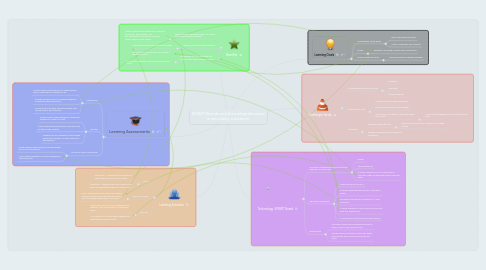
1. Learning Activities
1.1. MATH
1.1.1. GEOMETRY- manipulation/recognition of 2D/3D shapes on the SMART board
1.1.2. GRAPHING- students take turns using SMART board to manipulate graphs on a larger scale
1.2. SOCIAL STUDIES
1.2.1. MAPS- putting map onto board and allowing students to explore the map and apply what they find through exploration to a project
1.3. WRITING
1.3.1. GRAMMAR- put up incorrect sentences for students to go up and mark on the SMART board
1.3.2. It can help ESL students who struggle with writing with a pen and paper.
2. Learning Assessments
2.1. Interactions
2.1.1. SMART boards allow teachers to make different kinds of activities for students to do
2.1.2. It allows teachers to give immediate feedback to students about their work
2.1.3. SMART board can have educational apps that can be used in the classroom.
2.2. Quizzes
2.2.1. SMART boards allows teachers to make mini quizzes for students to take
2.2.2. It also shows what percentage of the class put for each of the answers
2.2.3. Teachers are also allowed to make review games like Jeopardy for the students to participate in.
2.3. Access to Online Information
2.3.1. SMART boards allow teacher to access reliable sources for information
2.3.2. It also allows students to conduct research on the board itself
3. Benefits
3.1. Shows students what they need to do which helps them understand better
3.1.1. Students have positive reactions, increased motivation, participation, and self-confidence, improved social skills, reduce need for note-taking
3.2. It gives a picture to a learning lesson
3.2.1. Visuals help students see the lesson clearer
3.3. The teacher can save activities and continue them the next day if need be.
3.3.1. Can also record lessons for subs to play if teacher is absent
3.3.2. Provides an easy way to pull up previous lesson plans
4. Technology: SMART Board
4.1. an interactive whiteboard that uses touch detection for user input
4.1.1. Finger
4.1.2. Smart Board pen
4.1.3. It allows students in ESL to participate in activities if they struggle with using a pen and paper
4.2. Electronic worksheets
4.2.1. Create and record lessons
4.2.2. Have sub show recorded lessons if teacher is absent
4.2.3. Templates with graphic organizers (i.e. Venn Diagrams)
4.2.4. It allows teachers to save an activity and come back to it another day
4.2.5. E-folios store student work/previous lessons
4.3. Going Green
4.3.1. Using the SMART board eliminates the use of paper, printing, and photocopying
4.3.2. SMART boards contribute to eliminate waste and pollution from using ink and paper too much
5. Challenges faced
5.1. If technology fails lesson may fail
5.1.1. Projector
5.1.2. Computer
5.1.3. Wireless internet
5.2. Distraction to class
5.2.1. Graphics can take away from lesson
5.2.2. Focus stuck to board, not to teacher
5.2.3. Only used by one person, those not using it don't focus
5.2.3.1. Leads to less engagement from the rest of the class
5.3. Installation
5.3.1. Expense (around $5,000)
5.3.1.1. Many school districts do not have room in their budget
5.3.2. Wiring of classroom could prevent its installation
6. Learning Goals
6.1. Comprehend Smart Board
6.1.1. Basic maneuvers and tasks
6.1.2. Useful to teachers and students
6.2. Create
6.2.1. Students can create projects with Smart Board
6.3. Overall classroom focus
6.3.1. Technology keeps students engaged

